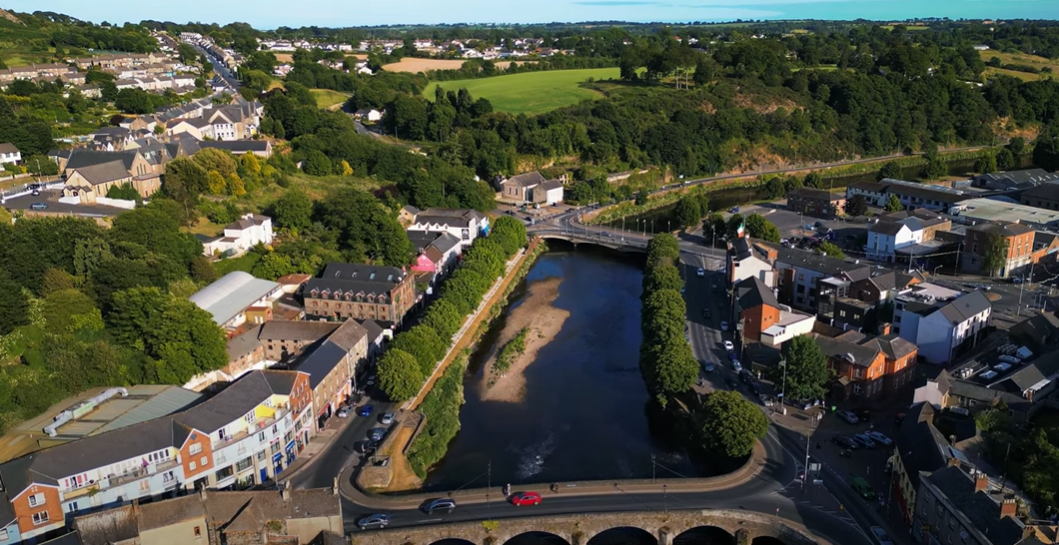The sunniest part of Ireland is the southeast region, particularly counties like Wexford and Waterford. These areas enjoy more sunshine throughout the year compared to other parts of the country, making them popular for outdoor activities and tourism. The southeast's milder climate and higher sunshine hours create a more pleasant environment, especially during the summer months.
During my visit to Waterford, I was surprised by how much sunshine the area received compared to other parts of Ireland I had explored. The clear skies and warm weather made it an ideal location for enjoying the beautiful coastline and vibrant local culture. It’s a part of Ireland I highly recommend if you're looking to experience the country's sunnier side.
What Affects Sunshine Levels in Ireland?
Geographical location, winds, and microclimates significantly influence sunshine levels in Ireland's weather. These elements combined determine the variation in sunlight that different parts of the country receive. Coastal regions, especially those facing the east, such as the sunny southeast and Dublin City, often enjoy more sunlight, as they are the first to greet the sun rising over the Irish Sea. In contrast, the western parts, facing the Atlantic on the west coast, frequently encounter cloudier conditions and higher precipitation due to prevailing westerly winds, which can dramatically reduce the amount of sunlight and result in the least annual hours of sunshine.
Microclimates, particularly in urban settings or sheltered valleys, further modify local sunshine patterns. These areas, including the sunniest counties like County Wexford in the sunny southeast, can either block or trap sunlight, resulting in noticeably different weather conditions over small distances. This introduction will be followed by a detailed examination of each factor to understand their specific impacts on Ireland's sunshine levels and identify areas with the most annual sunshine hours, such as the south-west corner with its relatively warmest weather.
Geographical Location
The geographical location significantly influences the distribution of sunshine across Ireland. Regions on the east coast, such as Dublin, typically enjoy more sunshine due to their strategic positioning relative to prevailing weather patterns. Here are detailed insights into how geographical factors impact sunlight exposure:
-
Orientation: Areas facing south and east generally receive more sunlight, particularly during the morning hours when the sun rises. This orientation maximizes exposure to the sun's rays, resulting in brighter mornings and sunnier days.
-
Coastal Influence: Coastal regions experience varied weather patterns. For example, the eastern shores of Ireland are often sheltered from the harsh Atlantic storms by their geographical position, leading to clearer skies and more sunny days compared to the more exposed western coastline.
-
Topography: The physical landscape, including mountains and valleys, can significantly affect local climates. Valleys that are oriented towards the south or are sheltered by mountains from the prevailing westerly winds tend to enjoy more sunshine.
-
Latitude: The farther south a location is in Ireland, the more potential sunshine it receives, especially during the longer days of summer.
These geographical nuances are essential for understanding why certain areas in Ireland are sunnier than others. It showcases how natural features can create microclimates that significantly vary from one region to another.
Winds
Winds play a significant role in affecting sunshine levels in Ireland, a key factor in the typical Irish weather. The country is influenced by prevailing westerly winds, which bring moist air from the Atlantic Ocean. These winds often result in cloud cover, particularly in the western and northern parts of Ireland, reducing sunshine levels in those areas. In contrast, the eastern and southeastern regions, including Dublin City and Co Wexford, which are somewhat shielded from these westerly winds by the central and western parts of the country, tend to experience less cloud cover and, therefore, higher levels of sunshine, especially in the sunny South East.
In essence, the direction and strength of the winds determine how much cloud cover an area might have, which directly impacts the amount of sunshine it receives, with areas like the South West corner often experiencing variations in sunlight due to these factors.
Microclimates
Ireland is renowned for its dynamic weather patterns, which can fluctuate dramatically from one region to another due to the presence of various microclimates. In Dublin City annually, the interaction between the Atlantic Ocean and Ireland's diverse topography plays a crucial role in shaping these local weather conditions. As a result, understanding microclimates is essential to identifying which areas of Ireland enjoy the most sunshine.
Microclimates arise when natural features like mountains, valleys, or bodies of water influence the climate of a small geographic area. These small-scale climate zones can have significantly different weather conditions than the general climate of the region. This is particularly evident in Ireland, where the terrain varies widely over short distances, affecting both temperature and solar exposure.
-
Coastal regions often experience different weather patterns compared to inland areas due to sea breezes that modify the temperature and sunshine hours.
-
Hills and mountains can create rain shadows, areas which receive less rainfall and more sunshine than regions on the windward side.
The existence of microclimates explains why some areas in Ireland bask in sunshine while others, just a few miles away, are cloaked in clouds. For travelers and residents alike, this variability means that local knowledge is invaluable for planning activities based on weather expectations. Moreover, understanding these microclimates is not only important for daily weather predictions but also for agricultural planning and tourism, influencing everything from crop selection to the best times for sunny holidays in Ireland.
Finally, the study of Ireland's microclimates offers valuable insights into how localized weather patterns can affect broader climatic conditions. This understanding is crucial for developing effective strategies for environmental conservation and sustainable living. By appreciating and studying these microclimates, one gains a deeper appreciation of Ireland's natural beauty and the complex interplay of elements that define its weather.
Which Parts of Ireland Receive the Most Sunshine?
The parts of Ireland that receive the most sunshine are located primarily in the southeast, with cities such as Wexford, Waterford, and Cork enjoying the highest levels of sunshine throughout the year. These areas benefit from a more favorable position relative to weather patterns, resulting in longer periods of clear skies and sunlight.
Wexford

-
Officially the sunniest county in Ireland.
-
Boasts an average of more than 7 hours of sunshine per day during the spring months.
-
The town of Rosslare in Wexford has recorded some of the highest annual sunshine totals in the country.
Waterford

-
Competes closely with Wexford for the title of the sunniest area.
-
Known for its beautiful, sunlit coastline which includes the famous Copper Coast.
-
Enjoys prolonged periods of sunshine, particularly from May through July, which enhances the appeal of its outdoor attractions.
Cork

-
While not as sunny as Wexford or Waterford, Cork still enjoys a relatively high amount of sunshine.
-
Receives around 1,400 to 1,500 hours of sunshine per year.
-
Its southern coastal location means it benefits from a milder climate, making it ideal for exploring local sites like Blarney Castle.
Carlow

-
Not as coastal as Wexford or Waterford, but still benefits from a favorable position in the southeast.
-
Records high sunshine hours, making it an ideal spot for gardening and outdoor sports.
Beyond the sunny havens of Wexford, Waterford, and Carlow, the southeast as a whole provides a delightful contrast to the more frequently cloud-covered parts of Ireland. It's a region where the sun casts a warm glow more often than not, creating an inviting atmosphere for visitors and residents alike. Whether it's exploring the vibrant streets of Waterford City or enjoying a tranquil sunset in the countryside of Carlow, the southeast offers a sunny disposition that is hard to match.
The abundance of sunshine in these areas not only enriches the daily life of the inhabitants but also contributes significantly to the local tourism and agriculture industries. Vineyards, orchards, and various outdoor recreational activities thrive under the generous sun. With such appealing weather, the southeast of Ireland continues to charm and attract people from all over the world, making it a bright spot on the map worth exploring.
What Makes Southeast Ireland the Sunniest Region?
Southeast Ireland is renowned for being the sunniest region in the country, a status attributed to a combination of geographical, meteorological, and climatic factors. This region, which includes counties such as Wexford, Waterford, and parts of Cork, consistently records higher sunshine hours than other parts of Ireland. Here's what makes Southeast Ireland the sunniest:
1. Geographical Position
-
Sheltered Location: Southeast Ireland is somewhat sheltered from the prevailing westerly winds that bring moisture-laden clouds from the Atlantic Ocean. These winds often lose much of their moisture by the time they reach the southeast, resulting in clearer skies.
-
Proximity to Mainland Europe: The southeastern region is closer to mainland Europe, which tends to have a more stable and sunnier climate. This proximity allows Southeast Ireland to experience some of these more favorable weather patterns.
2. Meteorological Factors
-
Lower Rainfall: Compared to the west and northwest, which are heavily impacted by Atlantic weather systems, the southeast experiences significantly lower rainfall. The reduced cloud cover means more sunlight reaches the ground, contributing to higher annual sunshine hours.
-
High-Pressure Systems: High-pressure systems, which bring dry and clear weather, are more frequent in the southeast. These systems prevent cloud formation and result in extended periods of sunshine, especially during the spring and summer months.
3. Climate Characteristics
-
Milder Winters: The southeast benefits from relatively milder winters compared to the rest of Ireland. The reduced cloud cover during these months allows for more sunlight, even during the shorter days of winter.
-
Longer Daylight Hours in Summer: During the summer, the southeast enjoys longer daylight hours, and with fewer clouds to block the sun, these areas receive more sunshine compared to other regions.
4. Local Influences
-
Coastal Benefits: Coastal areas like those in Waterford and Wexford enjoy more sunshine due to the moderating influence of the sea. The coastal breezes help disperse clouds, ensuring clearer skies.
-
Tourism and Agriculture: The sunny climate has a positive impact on tourism and agriculture. The extended sunshine hours boost the growth of crops and make the southeast a popular destination for tourists seeking outdoor activities.
Where Is the Warmest and Driest Place in Ireland?
The warmest and driest place in Ireland is generally considered to be the southeastern region, particularly Wexford and Waterford. These areas consistently record higher temperatures and lower rainfall compared to the rest of the country, making them the most favorable locations for those seeking warmer and drier conditions.
-
Average Sunshine: Wexford records more than 1,600 hours of sunshine annually.
-
Temperature Range: Summers are warm with average highs around 20°C, while winters are mild.
During my visit to Wexford last summer, I was pleasantly surprised by the warmth and sunshine that greeted me. Unlike other parts of Ireland where the weather can be unpredictable, Wexford offered clear skies and mild temperatures, perfect for exploring the scenic trails and historic sites. The consistent sunshine made it one of the most enjoyable experiences of my trip, allowing me to fully appreciate the beauty of Ireland's southeastern coast.
Activities to Enjoy in Ireland's Sunniest Areas
In Ireland's sunniest areas, such as Wexford and Waterford, you can enjoy outdoor activities like hiking, cycling, and exploring the coastline. These regions are known for their warmer temperatures and lower rainfall, making them ideal for soaking up the sun while discovering Ireland's natural beauty and historic sites. Whether you're wandering through lush gardens, visiting ancient castles, or enjoying a day at the beach, the southeastern part of Ireland offers a perfect blend of sunshine and adventure.
Outdoor Adventures
-
Hiking: Traverse scenic coastal and hillside trails that offer breathtaking views.
-
Biking: Cycle through paths illuminated by sunshine, enjoying the fresh Irish air and stunning landscapes.
Water Sports
-
Kayaking and Paddle Boarding: Paddle in the calm waters under the clear skies, perfect for beginners and experts alike.
-
Sailing: Set sail from quaint harbors to explore the coastlines bathed in sunshine.
Garden Tours
-
Exploring Gardens: Visit beautifully maintained gardens flourishing in the sunny climate, ideal for botanical enthusiasts.
-
Picnicking: Pack a lunch and relax in vibrant gardens, surrounded by blooming flowers and the sounds of nature.
Golfing
-
Golfing on Premier Courses: Experience golfing on some of Ireland’s top courses, known for their sunny dispositions and well-kept greens.
-
Skill Improvement: Take advantage of the clear weather to practice and improve your golfing skills with no interruptions.
FAQs On Sunniest Part of Ireland
1. What is the Sunniest Part of Ireland?
The sunniest part of Ireland is the southeast coast. This region enjoys the most sunshine, particularly during the spring and summer months.
2. Why is the Southeast Coast the Sunniest?
The southeast coast is the sunniest due to its geographical position which allows it to receive prolonged hours of sunshine, especially in comparison to the more northern and western parts of Ireland.
3. How Many Hours of Sunshine Does the Southeast Coast Receive?
The southeast coast typically receives over 1,600 hours of sunshine annually, making it the brightest area in Ireland.
4. What Time of Year is Sunniest on the Southeast Coast?
The sunniest time of year on the southeast coast is from May through July, when daylight is longest and sunshine is most frequent.
5. Can Tourists Expect Sunny Weather When Visiting the Southeast Coast?
Yes, tourists can generally expect sunny weather when visiting the southeast coast, especially if they plan their trip between late spring and early summer.
